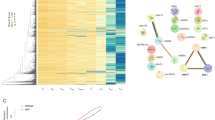Abstract
The transcriptional activation of enzymes involved in galactose utilization (GAL genes) in Saccharomyces cerevisiae is regulated by a complex interplay between three regulatory proteins encoded by GAL4 (transcriptional activator), GAL3 (signal transducer) and GAL80 (repressor). The relative concentrations of the signal transducer and the repressor are maintained by autoregulation. Cells disabled for autoregulation exhibit phenotypes distinctly different from that of the wild type cells, enabling us to explore the biological significance of autoregulation. The redundancy in signal transduction due to the presence of GAL1 (alternate signal transducer) also makes it a suitable model to understand the phenomenon of epigenetics. In this article we review some of the recent attempts made to understand the importance of epigenetics in the establishment of cellular and transcriptional memory.
Similar content being viewed by others
References
Acar M, Becskei A and van Oudenaarden A 2005 Enhancement of cellular memory by reducing stochastic transition; Nature (London) 435 228–231
Bhat P J and Murthy T V S 2001 Transcriptional control of the GAL/MEL regulon of yeast Saccharomyces cerevisiae: Mechanism of galactose mediated signal transduction; Mol. Micrbiol. 40 1059–1066
Bhat P J and Venkatesh K V 2005 Stochastic variation in the concentration of repressor activates GAL genetic switch: Implication in evolution of regulatory network; FEBS Lett. 579 597–603
Biggar S R and Crabtree G R 2001 Cell signaling can direct either binary or graded transcriptional response; EMBO J. 20 3167–3176
Brickner D G, Cajigas I, Foundefe-Mittendorf Y, Ahmed S, Lee P, Widom J and Brickner J H 2007 H2A.Z-mediated localization of genes at the nuclear periphery confers epigenetic memory of previous transcriptional state; PLoS 5 e81
Cohn M and Horibata K 1959a Inhibition by glucose of the induced synthesis of the β-Galactosidase-Enzyme system of Escherichia coli. Analysis of maintenance; J. Bacteriol. 78 601–612
Cohn M and Horibata K 1959b Analysis of the differentiation and of the heterogeneity within a population of Escherichia coli undergoing induced β-Galactosidase synthesis; J. Bacteriol. 78 613–623
Goldberg R F 1974 Autogenous regulation of gene expression; Science 183 810–816
Hawkins M K and Smolke C D 2006 The regulatory roles of galactose permease and Kinase in the induction response of the GAL network in Saccharomyces cerevisiae; J. Biol. Chem. 281 13485–13492
Hittinger C T and Carroll S B 2007 Gene duplication and the adaptive evolution of a classic genetic switch; Nature (London) 449 677–682
Kundu S, Horn P J and Peterson C L 2007 SWI/SNF is required for the transcriptional memory at the yeast GAL gene cluster; Gene. Dev. 21 997–1004
Melcher K and Xu H E 2001 Gal80-Gal80 interaction on adjacent Gal4p binding sites is required for complete GAL gene repression; EMBO J. 20 841–851
Novick A and Weiner M 1957 Enzyme induction as an all or non phenomenon; Proc. Natl. Acad. Sci. USA 43 553–566
Ptashne M 2007 On the use of the word “Epigenetics”; Curr. Biol. 17 R233–R236
Ramsey S A, Smith J J, Orell D, Merille M, Peterson T W, de Atauri P, Bolouri H and Aitchison J D 2006 Dual feed back in the GAL regulon suppresses cellular heterogeneity in the yeast; Nat. Genet. 38 1082–1087
Rubio-Texeria M 2006 A comparative analysis of GAL genetic switch between not-s-distant cousins: Saccharomyces cerevsiae and Kluyveromyces lactis; FEMS Yeast Res. 5 1115–1128
Spiegelman S 1951 The particulate transmission of enzyme forming capacity in yeast; Cold Spring Harbor Symp. Quant. Biol. 16 87–98
Traven A, Jelicic B and Sopta M 2006 Yeast GAL4: A transcriptional paradigm revisited; EMBO Reports 7 496–499
Verma M, Bhat P J and Venkatesh K V 2003 Quantitative analysis of GAL genetic switch of Saccharomyces cerevisiae reveals that nucleocytoplasmic shuttling of Gal80p results in a highly sensitive response to galactose; J. Biol. Chem. 278 48764–48769
Winge O and Roberts C 1948 Inheritance of enzymatic characters in yeast and the phenomenon of long term adaptation; C. R. Trav. Lab. Carlsberg. Ser. Physiol. 24 264–315
Zacharioudakis I, Gligoris T and Tzamarias D 2007 A yeast catabolic enzyme controls transcriptional memory; Curr. Biol. 17 2041–2046
Author information
Authors and Affiliations
Corresponding author
Rights and permissions
About this article
Cite this article
Bhat, P.J., Iyer, R.S. Epigenetics of the yeast galactose genetic switch. J Biosci 34, 513–522 (2009). https://doi.org/10.1007/s12038-009-0070-y
Published:
Issue Date:
DOI: https://doi.org/10.1007/s12038-009-0070-y




